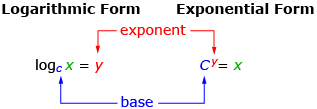In Try This 2 you may have noticed that the logarithm is equal to the exponent from the exponential form. The relationship between the logarithmic and exponential forms are summarized in the illustration shown.
 1
1
Logarithms with base 10 are often used and are called common logarithms. An example of a common logarithm is when you evaluated log 1000. There is no base written, but it is assumed that the base is 10. So, log 1000 is the same as log10 1000.
View Evaluating Logarithms for more examples of how to evaluate logarithms. Compare this method of evaluation with your table from Try This 2.
Here is another explanation of logarithms: “Introduction to Logarithms.” However, if you feel confident with logarithms, skip the video and move on to Self-Check 1.

